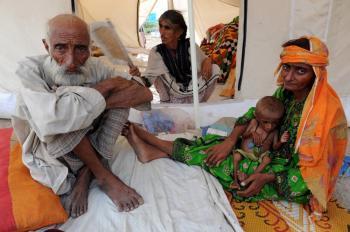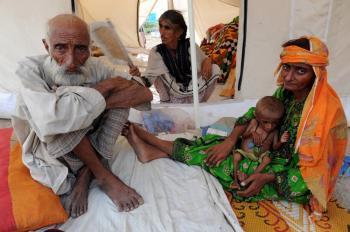One out of six people inhabiting the earth will suffer chronic hunger this year, and a child will die every six seconds because of undernourishment related problems, said reports released in recent days.
Figures released by the Food and Agriculture Organization (FOA) and the World Food Program (WFP) on Sept. 14, estimate that the number of people who suffer chronic hunger in 2010 dropped by 98 million compared to the year before, leaving 925 million hungry, corresponding to 13.5 percent of the world’s population.
Two-thirds of the world’s hungry live in just seven countries: Bangladesh, China, the Democratic Republic of Congo, Ethiopia, India, Indonesia, and Pakistan.
Overall, Asia and the Pacific have the most undernourished people at 578 million. Since July Pakistan has also been devastated by floods covering one-fifth of the country, destroying farmland, and submerging entire villages. It is estimated to have affected 20 million of the world’s poorest people.
The new numbers were released Tuesday in advance of the Sept. 20-22 Summit meeting in New York called to speed progress toward achievement of the Millennium Development Goals set by the U.N. in 2000.
In 2000, world leaders pledged to cut in half the proportion of the world’s hungry from 20 to 10 percent by 2015. According to the new numbers, only 0.05 percent has been shaved off the 2000 figure with 13.5 percent of the world suffering hunger today compared to 14 percent in 2009.
Although the numbers dipped over the last year, Gawain Kripke, policy director for Oxfam America, indicated in a statement that it shows little real progress.
“A billion hungry people is more than a food crisis, it’s a political crisis,” said Kripke.
“World leaders have made grand promises before, but promises don’t make nutritious meals and viable livelihoods.”
Figures released by the Food and Agriculture Organization (FOA) and the World Food Program (WFP) on Sept. 14, estimate that the number of people who suffer chronic hunger in 2010 dropped by 98 million compared to the year before, leaving 925 million hungry, corresponding to 13.5 percent of the world’s population.
Two-thirds of the world’s hungry live in just seven countries: Bangladesh, China, the Democratic Republic of Congo, Ethiopia, India, Indonesia, and Pakistan.
Overall, Asia and the Pacific have the most undernourished people at 578 million. Since July Pakistan has also been devastated by floods covering one-fifth of the country, destroying farmland, and submerging entire villages. It is estimated to have affected 20 million of the world’s poorest people.
The new numbers were released Tuesday in advance of the Sept. 20-22 Summit meeting in New York called to speed progress toward achievement of the Millennium Development Goals set by the U.N. in 2000.
In 2000, world leaders pledged to cut in half the proportion of the world’s hungry from 20 to 10 percent by 2015. According to the new numbers, only 0.05 percent has been shaved off the 2000 figure with 13.5 percent of the world suffering hunger today compared to 14 percent in 2009.
Although the numbers dipped over the last year, Gawain Kripke, policy director for Oxfam America, indicated in a statement that it shows little real progress.
“A billion hungry people is more than a food crisis, it’s a political crisis,” said Kripke.
“World leaders have made grand promises before, but promises don’t make nutritious meals and viable livelihoods.”
Continued on the next page...
Causes of Hunger
Yukiko Omura, vice president of International Fund for Agricultural Development (IFAD) noted that it was ironic that the majority of the hungry people lived in rural areas with about 80 percent of them being engaged in farming in some way.
What lies behind the apparent contraction, according to Oxfam America, is the neglect of the agricultural sectors in developing countries that started several decades ago.
National governments in the developing world began abandoning investment in agriculture in the 1980s. During the same period, industrialized countries were increasing support for their farmers, using tariff and technical barriers to protect them from imports.
International financial institutions like International Monetary Fund ended up contributing to the problem when imposed structural adjustment policies led indebted governments to neglect local food production. Required dramatic cuts in public spending forced governments to dismantle any agricultural research programs.
At the same time, global donors began directing their aid dollars to emergency relief, and social sectors programs in health and education. Without any intervention or attention, agricultural productivity stagnated.
For example, world grain yields rose by just 1.2 percent annually from 1990 to 2000, compared with 2.1 percent between 1960 and 1990. Sub-Saharan Africa, where two-thirds of the land is remote or unfertile, has felt the brunt of the decline.
“A new global food crisis could explode at any time unless governments tackle the underlying causes of hunger,” said Oxfam’s Kripke in a statement.
“Hunger remains the world’s largest tragedy and scandal,“ said FAO Director-General Jacques Diouf on the FAO website. ”This is absolutely unacceptable.”
What also affects access to food is income and prices. According to David Dawe, a senior economist at FAO, although wheat prices have been rising since July because of drought and fire in Russia, he does not expect it to impact prices overall.
“We should not see a repeat of the 2008 food price crisis when global stocks of grains were low, we have ample stocks now,” wrote Dawe in a U.N. news report published by Integrated Regional Information Networks (IRIN).
National governments in the developing world began abandoning investment in agriculture in the 1980s. During the same period, industrialized countries were increasing support for their farmers, using tariff and technical barriers to protect them from imports.
International financial institutions like International Monetary Fund ended up contributing to the problem when imposed structural adjustment policies led indebted governments to neglect local food production. Required dramatic cuts in public spending forced governments to dismantle any agricultural research programs.
At the same time, global donors began directing their aid dollars to emergency relief, and social sectors programs in health and education. Without any intervention or attention, agricultural productivity stagnated.
For example, world grain yields rose by just 1.2 percent annually from 1990 to 2000, compared with 2.1 percent between 1960 and 1990. Sub-Saharan Africa, where two-thirds of the land is remote or unfertile, has felt the brunt of the decline.
“A new global food crisis could explode at any time unless governments tackle the underlying causes of hunger,” said Oxfam’s Kripke in a statement.
“Hunger remains the world’s largest tragedy and scandal,“ said FAO Director-General Jacques Diouf on the FAO website. ”This is absolutely unacceptable.”
What also affects access to food is income and prices. According to David Dawe, a senior economist at FAO, although wheat prices have been rising since July because of drought and fire in Russia, he does not expect it to impact prices overall.
“We should not see a repeat of the 2008 food price crisis when global stocks of grains were low, we have ample stocks now,” wrote Dawe in a U.N. news report published by Integrated Regional Information Networks (IRIN).








